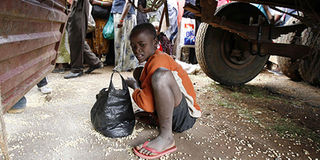Kenya now needs Sh46bn for food

A boy collects maize that dropped from a truck carrying food aid. Kenya Red Cross has warned that the hunger situation is getting worse in Samburu, Moyale, Tana River, Narok, Murang’a, Nyeri and Ukambani. Photo/REUTERS
A revised appeal of Sh46 billion has been launched to ease Kenya’s deteriorating hunger situation. Humanitarian agencies working with the government have come up with the revised emergency response plan amid fears that the drought situation is worsening by the day.
The revised plan was unveiled two months after President Kibaki declared the food crisis an emergency and appealed for Sh37 billion assistance to respond to the crisis.
Two months later, the situation has failed to improve due to the poor short rains and rising food prices. Some Sh7.6 billion has been donated since the launch of the appeal.
Kenya Red Cross has warned that the situation is getting worse in Samburu, Moyale, Tana River, Narok, Murang’a, Nyeri and Ukambani.
Announcing the revised plan on Wednesday, the United Nations Office for the Coordination of Humanitarian Affairs said it was essential to provide life-saving food aid to an estimated 3.5-4.5 million people. It said livestock diseases and insecurity in parts of the country had contributed to the deteriorating situation.
Although 347,418 internal refugees had returned to their homes or were in transit, many of the sites have inadequate hygiene and health facilities and limited access to schools.
Refugee influx
Instability in neighbouring Somalia has seen a marked increase in the refugee influx to Kenya. “Humanitarian partners have therefore reviewed their requirements to respond to existing and emerging needs,” said the UN body.
According to Special Programmes minister Naomi Shaaban, however, the answer to Kenya’s food insecurity was in long-term interventions such as provision of farm inputs to farmers.
She said President Kibaki recently launched the Njaa Marufuku (get rid of hunger) programme through which farmers in grain basket areas would access free inputs or at a subsidised price.




